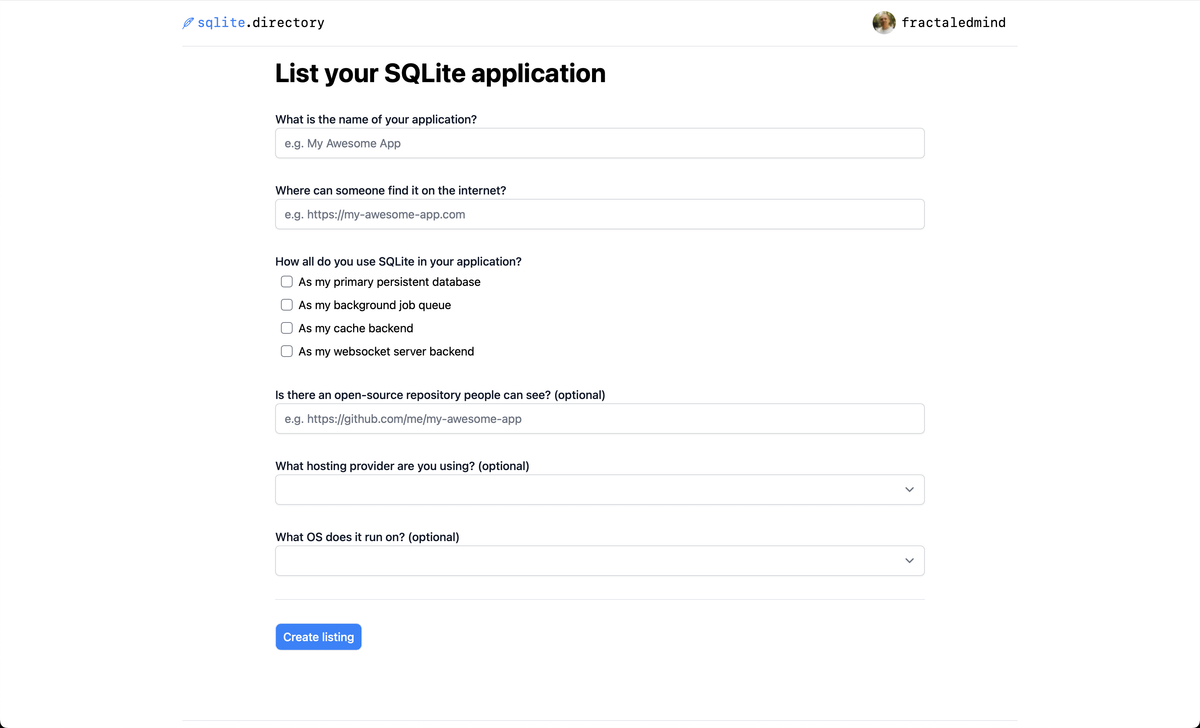-
sqlite.directory updates
After the initial launch of sqlite.directory, I have been working on a few updates to the site. Here are some of the updates:
- Show count of apps (
59ba725) - Show favicon of app (
d89dfbe) - Randomize the order of app entries (
d703bf9) - Validate that even the optional Repository URL is a valid URL (
15ad911 - Make the application more responsive (
07a5a3d,ea01025,e370f9d,daed3ab,5568fdd,93c5c43, and3b8cf5e) - Update the PWA manifest to improve colors, description, and quick actions (
31422f6)
As of writing this (December 11, 2024 at 1:30 PM CET) there are 17 applications listed on the site. I am excited to see the site grow and to see more applications listed on the site. If you have a project that uses SQLite, please consider adding it to the site. You can do so by visiting sqlite.directory and clicking the “Add entry” button. I am looking forward to seeing your project listed on the site!
Continue reading … - Show count of apps (
-
Loading extensions
Rails continues to expand its lead as the single best platform for building web applications backed by SQLite! You can now load extensions directly from the
Continue reading …database.ymlfile. This now means you have quick and easy access to the full range of SQLite extensions. This is a major step forward from the previous way, which required writing a custom initializer or using the enhanced adapter. -
Introducing sqlite.directory
sqlite.directoryis a directory of web applications that use the SQLite database engine in some meaningful capacity in production. I have just launched the initial release today. Check it out and list your SQLite-backed app today: https://sqlite.directory
Continue reading …
-
Supercharge the One Person Framework with SQLite: Rails World 2024
Continue reading … -
Problems with a backoff busy handler
In the process of getting the non-blocking
Continue reading …busy_timeoutfrom thesqlite3gem used in Rails, I needed to explore the differences between a busy handler implementation that uses a backoff and one that simply polls on a consistent interval. What I found was that a busy handler that backs off kills “tail latency” (how long it takes for the operation in the worst cases). This is because the SQLite “retry queue” behaves very differently from a more traditional queue that we tend to work with and think about, like a background job queue. -
The how and why of optimal performance
Continue reading …
-
Isolated connection pools
If you want to squeeze as much performance out of your SQLite on Rails application, at some point you will need to confront the problem of writes saturating your connection pool. Let’s dig into this problem and how to solve it with some clever usage of Rails’ multi-database support.
Continue reading … -
Non-blocking timeout
Last month I released version 0.4.0 of the
Continue reading …activerecord-enhancedsqlite3-adaptergem, which added support for a non-blockingbusy_timeoutto the SQLite adapter in Rails. As with all of my lower-level SQLite work, the goal is always to push these solutions into the foundations of the ecosystem so that everyone can benefit from them. In this case, I’m happy that thebusy_timeoutfeature has made its way into thesqlite3gem, which is the most popular SQLite gem for Ruby. -
SQLite Quick Tip: Multiple Databases
When building a full-featured Rails application, you will want not just a database to store your model data; you will want a job queue backend, a cache backend, maybe even a pubsub backend. When building a Rails app leveraging the power and simplicity of SQLite, you will likely wonder how best to architect these various services? 37signals has been releasing new gems to use solid-state storage via relational databases. They default to using one database to back all of these services, but they use MySQL. How should we handle this with SQLite?
Continue reading … -
Installing extensions
In a previous post, we discussed how to load SQLite extensions distributed as Ruby gems into a Ruby on Rails application. Unfortunately, there aren’t many SQLite extensions that are distributed as Ruby gems. So, in this post, we dig into how to install a wider range of SQLite extensions into our apps.
Continue reading …
